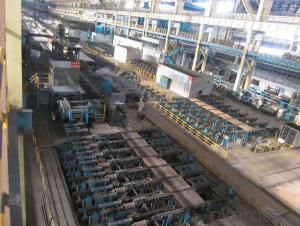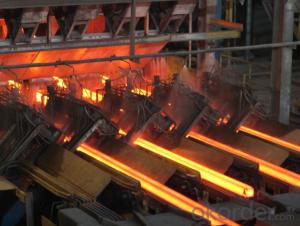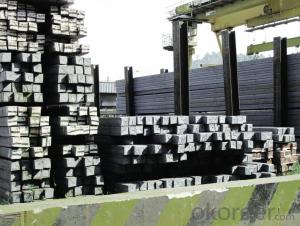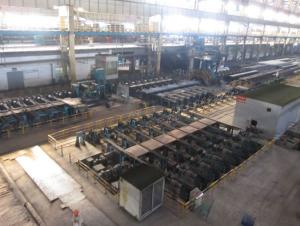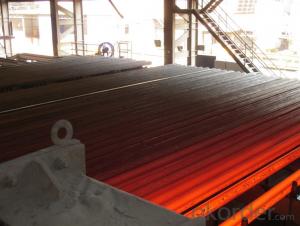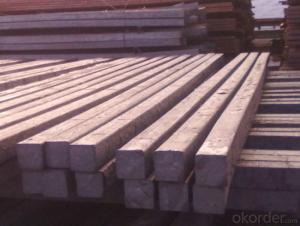Hot Rolled Square Steel Billet 3SP Standard 95mm
- Loading Port:
- Shanghai
- Payment Terms:
- TT OR LC
- Min Order Qty:
- 2000 m.t.
- Supply Capability:
- 10000 m.t./month
OKorder Service Pledge
OKorder Financial Service
You Might Also Like
Structure of Hot Rolled Square Steel Billet 3SP Standard 95mm

Description of Hot Rolled Square Steel Billet 3SP Standard 95mm
PPGI is made by cold rolled steel sheet and galvanized steel sheets as baseplate, through the surface pretreatment (degreasing, cleaning, chemical conversion processing), coated by the method of continuous coatings (roller coating method),
and after roasting and cooling. Zinc coating: Z60, Z80, Z100, Z120, Z180, Z275, G30, G60, G90
Alu-zinc coating: AZ60, AZ80, AZ100, AZ120, AZ180, G30, G60, G90

Main Feature of Hot Rolled Square Steel Billet 3SP Standard 95mm
1) Excellent corrosion resistance: The zinc layer provides a good protection of Pre-painted Galvanizeed Steel Sheet.
2) High heat resistance: The reflective surface of the material aids in efficiently reflecting the sunlight away and in turn reducing the amount of heat transmitted. The thermal reflectivity converts into energy savings.
3) Aesthetics: Pre-Painted Galvanized steel sheet is available in plethora of patterns and multiple sizes as per the requirements that given by our customers.
4) Versatility: can be used in the various areas.Standard seaworthy export packing: 3 layers of packing, inside is kraft paper, water plastic film is in the middle and outside GI steel sheet to be covered by steel strips with lock, with inner coil sleeve.
Applications of Hot Rolled Square Steel Billet 3SP Standard 95mm
1) Automotive bodies: filters, fuel tanks, etc.
2) Construction materials: roofings, welding pipes,
3) Electric and electronic appliances: computer cans, etc.
4) Steel cans: containers, etc.
5) Steel furniture: washing machines, refrigerators, microwaves, etc.
6) Drums
7) Office equipment: printer, recorders, etc.
8) Motors and transformers

Specifications of Hot Rolled Square Steel Billet 3SP Standard 95mm
| Classified symbol | Yield Point Minimum N/mm2 | Tensile Strength Minimum | Elongation Minimum % | Application | ||||
| N/mm2 | Nominal Thickness mm (t) | |||||||
| JIS | Yogic | 0.25-0.4 | 0.4-0.6 | 0.6-1.0 | 1.0-1.6 | |||
| G3312 | specification | |||||||
| CGCC | CGCC | -205 | -270 | -20 | -21 | -24 | -24 | Commercial |
| CGCD | CGCD | --- | 270 | --- | 27 | 31 | 32 | Drawing |
| --- | CG340 | 245 | 340 | 20 | 20 | 20 | 20 | Structural |
| CGC400 | CG400 | 295 | 400 | 16 | 17 | 18 | 18 | Structural |
| CGC440 | CG440 | 335 | 440 | 14 | 15 | 16 | 18 | Structural |
| CGC490 | CG490 | 365 | 490 | 12 | 13 | 14 | 16 | Structural |
| CGC570 | CG570 | 560 | 570 | --- | --- | --- | --- | Structural |
| ASTM Designation | Yield Point Minimum | Tensile Strength Minimum | Elongation Minimum % | Application | Q/BQB 445-2004(China standard) | ASM A653/A653M | JISG 3312 | |
| ksi(MPa) | ksi(MPa) | TDC51D+Z | (CS TYPE A+Z) | CGCC | ||||
| A653(M)-99 CS TYPE A,B,C | --- | --- | --- | Commercial | TDC52D+Z | CGCD | ||
| A653(M)-99 FS | --- | --- | --- | Lock Forming | TS250GD+Z | (G250+Z) | - | |
| A653(M)-99 DS | --- | --- | --- | Drawing | TS300GS+Z | (G300+Z) | CGC 400 | |
| A653(M)-99 SS Grade33(230) | 33(230) | 45(310) | 20 | Structural | TS350GD+Z | (G350+Z) | CGC490 | |
| A653(M)-99 SS Grade37(255) | 37(255) | 52(360) | 18 | Structural | TS550GD+Z | (G550+Z) | CGC570 | |
| A653(M)-99 SS Grade40(275) | 40(275) | 55(380) | 16 | Structural | ||||
| A653(M)-99 SS Grade50(345) | 50(345) | 65(450) | 12 | Structural | ||||
| A653(M)-99 SS Grade80(550) | 80(550) | 82(570) | --- | Structural | ||||
FAQ of Hot Rolled Square Steel Billet 3SP Standard 95mm
We have organized several common questions for our clients,may help you sincerely:
1. How Can I Visit There?
Our company is located in Tianjin City, China, near Beijing. You can fly to Tianjin Airport Directly. All our clients, from home or aboard, are warmly welcome to visit us!
2. How Can I Get Some Sample?
We are honored to offer you sample.
3. Why choose CNBM?
1, ISO, BV, CE, SGS approved.
2, Competitive price and quality.
3, Efficient service team online for 24 hours.
4, Smooth production ability(50000tons/month) .
5, quick delivery and standard exporting package.
6, Flexible payment with T/T, L/C, Paypal, Kunlun bank, etc .
- Q:What is the role of steel billets in the construction of commercial buildings?
- Steel billets play a crucial role in the construction of commercial buildings as they are the primary raw material used for manufacturing structural steel sections. These sections are used to construct the framework, columns, beams, and other load-bearing elements of the building. The high strength and durability of steel make it an ideal material for commercial buildings, as it can withstand heavy loads, resist deformation, and provide structural integrity. Steel billets are melted and cast into various shapes and sizes to create different sections, such as I-beams, H-beams, channels, angles, and plates. These sections are then fabricated, welded, and assembled to form the skeletal structure of the building. Steel billets are often utilized to produce long steel bars or rods, which are commonly used as reinforcement in concrete structures. Reinforced concrete is widely used in commercial buildings due to its ability to combine the compressive strength of concrete with the tensile strength of steel. Moreover, steel billets are essential in providing stability and support to the overall structure. They help distribute the weight and loads evenly throughout the building, ensuring the safety and integrity of the construction. Additionally, steel is a highly fire-resistant material, reducing the risk of damage in case of fire incidents and enhancing the overall safety of the building. Furthermore, steel billets offer design flexibility and cost-effectiveness. They can be easily fabricated and customized to meet the specific requirements of the building design, allowing architects and engineers to create innovative and efficient structures. Steel structures are also lightweight compared to traditional construction materials, reducing the overall weight of the building and potentially lowering construction costs. In conclusion, steel billets are integral to the construction of commercial buildings as they provide the necessary strength, durability, and stability required for the structural framework. Their versatility, fire-resistance, and cost-effectiveness make them a preferred choice for architects, engineers, and contractors in the construction industry.
- Q:What are the different surface treatments for steel billets?
- There are several different surface treatments that can be applied to steel billets to enhance their performance and protect them from corrosion. One common surface treatment is hot-dip galvanizing, where the steel billets are dipped into a bath of molten zinc. This creates a protective coating of zinc on the surface of the billets, which acts as a barrier against moisture and other corrosive elements. Another option is electroplating, where a thin layer of metal, such as chromium or nickel, is deposited onto the surface of the steel billets using an electric current. This not only provides corrosion resistance but can also improve the appearance of the billets. A third surface treatment method is painting or powder coating. This involves applying a layer of paint or dry powder onto the surface of the billets. The paint or powder forms a protective barrier that prevents moisture and other corrosive substances from reaching the steel. Additionally, shot blasting or sandblasting can be used as a surface treatment for steel billets. This involves propelling abrasive particles at high speeds onto the surface of the billets to remove any impurities or scale, leaving a clean and smooth finish. Lastly, there are also chemical treatments available for steel billets. One example is phosphating, where the steel is immersed in a phosphoric acid solution, resulting in the formation of a protective phosphate coating on the surface. This coating improves corrosion resistance and promotes paint adhesion. Overall, the choice of surface treatment for steel billets depends on the specific requirements of the application and the desired level of protection against corrosion and other environmental factors.
- Q:What are the different types of steel billet rolling mill equipment?
- In the manufacturing process, a variety of equipment is utilized in the steel billet rolling mill. Here are some of the most commonly used types: 1. To achieve the necessary temperature for rolling, steel billets are heated using reheating furnaces. These furnaces utilize either fuel or electricity to generate the required heat, ensuring that the billets reach the optimal temperature. 2. In order to reduce the billet size and prepare them for subsequent rolling passes, roughing stands are employed. These stands consist of multiple rolls that gradually decrease the billet thickness as they pass through. 3. Once the roughing process is complete, the billets proceed to the intermediate stands. Here, the billets undergo further thickness reduction and are shaped into the desired profile. 4. The billets then move on to the finishing stands, which possess a set of rolls responsible for giving the steel its final shape and size. These stands play a crucial role in achieving precise dimensions and the required surface finish. 5. Cooling beds are utilized to gradually cool down the steel billets after the rolling process. This controlled environment ensures that the billets do not experience any distortion or cracking before further processing. 6. Shearing machines are employed to cut the rolled steel billets into specific lengths. These machines, whether hydraulic or mechanical, guarantee precise and accurate cutting according to the desired specifications. 7. Straightening machines are used to correct any slight deformations or unevenness in the rolled billets. Their purpose is to ensure that the steel is straight and ready for further processing. 8. Various inspection equipment, including ultrasonic testers, are employed to assess the quality and integrity of the rolled steel billets. These equipment guarantee that the final product meets the necessary standards and specifications. In summary, these various types of steel billet rolling mill equipment work in harmony to transform raw steel billets into finished products with the desired shape, size, and quality. The selection and arrangement of these equipment depend on the specific requirements of the manufacturing process and the intended end product.
- Q:How do steel billets come out?
- I. mining1, iron ore2 limestone mine3, coal mineTwo 、 burden preparation1. Iron ore sintering2 coking coal cokingThree, iron: in the blast furnace, sintering iron ore, limestone, coke, iron ore in the iron elements reduced to metal iron, then the product is pig iron.
- Q:What are the main factors that determine the demand for steel billets in different industries?
- The demand for steel billets in different industries is influenced by several factors. 1. Economic conditions: The overall state of the economy plays a crucial role in determining the demand for steel billets. During periods of economic growth and increased construction activities, there is typically a higher demand for steel billets in industries such as construction, infrastructure, and manufacturing. 2. Construction and infrastructure projects: The demand for steel billets is closely tied to construction and infrastructure projects. These projects require substantial amounts of steel for various purposes, including structural support, reinforcement, and fabrication. The level of investment in construction and infrastructure projects directly affects the demand for steel billets. 3. Manufacturing activities: Steel billets are used as raw material in various manufacturing processes, including automotive, aerospace, machinery, and equipment manufacturing. The demand for steel billets in these industries is directly influenced by the level of manufacturing activities and the overall production output. 4. Technological advancements: Technological advancements and innovation can also impact the demand for steel billets. As new technologies emerge and industries evolve, the demand for steel billets may change. For example, the rise of electric vehicles has increased the demand for steel billets in the automotive industry due to the need for lightweight yet strong materials. 5. International trade and globalization: The demand for steel billets can be affected by international trade dynamics and globalization. The expansion of global supply chains and the growth of emerging economies can lead to increased demand for steel billets in different regions. Changes in trade policies or tariffs can also influence the demand for steel billets in certain industries. 6. Environmental regulations: Increasing environmental regulations and sustainability initiatives can impact the demand for steel billets. Industries that are required to reduce their carbon footprint may opt for alternative materials or adopt more efficient manufacturing processes, which could affect the demand for steel billets. 7. Price and availability: The price and availability of steel billets can significantly impact demand. Fluctuations in steel prices, supply chain disruptions, or shortages of raw materials can influence the demand for steel billets in different industries. Additionally, the availability of substitutes or alternative materials can also affect the demand for steel billets. In conclusion, the demand for steel billets in different industries is influenced by economic conditions, construction and infrastructure projects, manufacturing activities, technological advancements, international trade, environmental regulations, and price and availability factors. Understanding these factors is essential for predicting and analyzing the demand for steel billets in various industries.
- Q:What are the potential applications of steel billets in the chemical industry?
- Due to their unique properties and versatility, steel billets have numerous potential applications in the chemical industry. One primary use of steel billets in the chemical industry involves their utilization in the production of various types of equipment and machinery. Steel billets can be shaped and forged into different forms, such as pipes, tanks, valves, and fittings, which are crucial for the handling and storage of chemicals. These components need to withstand harsh conditions, including high temperatures, pressures, and corrosive environments, thereby making steel billets an ideal material choice. Additionally, steel billets can be employed in the construction of chemical plants and facilities. They provide exceptional structural support, ensuring the stability and integrity of the buildings. Steel billets are often used in fabricating beams, columns, and other load-bearing elements, providing strength and durability to withstand the chemical processes occurring within the plant. Another potential application of steel billets in the chemical industry pertains to the manufacturing of reaction vessels and reactors. These vessels are utilized for chemical reactions, such as synthesis, distillation, and purification processes. Steel billets can be machined and formed into the desired shape, allowing for the creation of robust and reliable vessels that can handle the high pressures and temperatures often required in chemical reactions. Furthermore, steel billets can be utilized in the production of catalysts used in various chemical processes. Catalysts are substances that expedite chemical reactions without being consumed in the process. Steel billets can serve as a base material for catalysts, providing a stable and durable support structure for the active catalytic components. Moreover, steel billets can be employed in the construction of storage tanks and containers for the transportation and storage of chemicals. Steel billets offer exceptional resistance to corrosion and can be easily welded and fabricated into large containers, ensuring the safe and secure storage of hazardous chemicals. In summary, steel billets possess vast potential applications in the chemical industry. Their strength, durability, and resistance to corrosion make them indispensable materials for various chemical processes and operations, encompassing equipment fabrication, construction projects, catalyst manufacturing, and storage solutions.
- Q:Can steel billets be forged?
- Yes, steel billets can be forged. Forging is a common method used to shape metals into desired forms by applying compressive forces. Steel billets, which are semi-finished products in the form of rectangular bars, can undergo forging to transform them into various shapes such as bars, plates, or complex geometries. During the forging process, the steel billets are heated to a specific temperature to make them malleable, and then they are subjected to mechanical forces using hammers, presses, or other forging equipment. This enables the billets to be shaped and compressed, thereby improving their mechanical properties and imparting specific characteristics to meet desired requirements. Overall, forging steel billets is an important process in the production of various metal components and products.
- Q:What are the safety precautions when handling steel billets?
- To minimize the likelihood of accidents and injuries when dealing with steel billets, it is crucial to adhere to various safety measures. Firstly, it is of utmost importance to wear suitable personal protective equipment (PPE) such as safety goggles, steel-toed boots, gloves, and a hard hat. Before commencing the handling of steel billets, it is necessary to ensure that the work area is free from any obstructions or debris that could potentially cause trips or falls. Additionally, it is essential to stack and store the billets correctly to prevent unexpected falls or shifts. When it comes to lifting or moving steel billets, one should exercise caution regarding their weight and size. Utilizing appropriate lifting equipment like cranes, forklifts, or hoists is necessary to avoid strains or musculoskeletal injuries. It is crucial to always adhere to the weight limits and load capacities specified for the equipment being employed. To prevent slippage or falling, it is important to maintain a secure grip on the billets. One should avoid sharp edges or protruding parts that could result in cuts or puncture wounds. If required, the use of protective covers or padding can prevent contact with sharp or jagged edges. Proper communication plays a vital role in the handling of steel billets. It is imperative to establish clear communication among the workers involved in the process to prevent accidents or mishaps. Hand signals or radios can be employed to facilitate effective communication, especially in noisy environments. Regular inspection of the steel billets should be conducted before handling them to identify any defects or damage. Cracks, rust, or any other issues can compromise the structural integrity of the billets and increase the risk of accidents. If any defects are detected, they should be reported to a supervisor, and the appropriate procedures for handling or disposing of the billets should be followed. Lastly, it is crucial to always be aware of one's surroundings and the movements of other workers when handling steel billets. Standing or working in the swing radius of lifting equipment or near moving machinery should be avoided to prevent being struck or crushed. By adhering to these safety precautions, the risk of accidents and injuries during the handling of steel billets can be significantly reduced, thereby creating a safer work environment.
- Q:Are there any alternative materials to steel billets in certain applications?
- Yes, there are several alternative materials to steel billets in certain applications. Some commonly used alternatives include aluminum billets, copper billets, and titanium billets. Each of these materials possesses unique properties and characteristics that make them suitable for specific applications where steel may not be the most ideal choice. For example, aluminum billets are lightweight and have excellent corrosion resistance, making them suitable for industries such as aerospace and automotive. Copper billets are known for their superior electrical conductivity, making them commonly used in electrical and electronic applications. Titanium billets offer exceptional strength, low density, and high heat resistance, making them suitable for industries such as aerospace, military, and medical. Ultimately, the choice of alternative material depends on the specific requirements and demands of the application in question.
- Q:What is the shelf life of a steel billet?
- The shelf life of a steel billet can vary depending on several factors. Steel billets are typically stored in controlled environments to prevent corrosion and maintain their quality. If stored properly, steel billets can have a shelf life of several years. However, it is important to note that the shelf life can be affected by factors such as the level of humidity, exposure to moisture or chemicals, and the specific type of steel used. Therefore, it is crucial to follow storage guidelines provided by manufacturers to ensure the prolonged shelf life of steel billets. Regular inspections and maintenance can also help in identifying any potential issues that may affect the shelf life of the billets.
1. Manufacturer Overview |
|
|---|---|
| Location | |
| Year Established | |
| Annual Output Value | |
| Main Markets | |
| Company Certifications | |
2. Manufacturer Certificates |
|
|---|---|
| a) Certification Name | |
| Range | |
| Reference | |
| Validity Period | |
3. Manufacturer Capability |
|
|---|---|
| a)Trade Capacity | |
| Nearest Port | |
| Export Percentage | |
| No.of Employees in Trade Department | |
| Language Spoken: | |
| b)Factory Information | |
| Factory Size: | |
| No. of Production Lines | |
| Contract Manufacturing | |
| Product Price Range | |
Send your message to us
Hot Rolled Square Steel Billet 3SP Standard 95mm
- Loading Port:
- Shanghai
- Payment Terms:
- TT OR LC
- Min Order Qty:
- 2000 m.t.
- Supply Capability:
- 10000 m.t./month
OKorder Service Pledge
OKorder Financial Service
Similar products
New products
Hot products
Hot Searches
Related keywords
